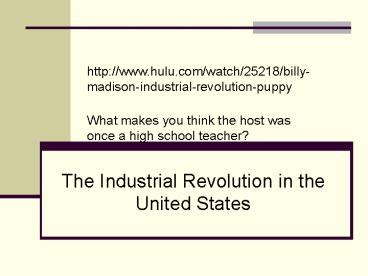The Industrial Revolution in the United States - PowerPoint PPT Presentation
1 / 21
Title:
The Industrial Revolution in the United States
Description:
Title: Seminar One Author: Julia Teahen Last modified by: Authorized User Created Date: 4/19/2002 5:19:21 PM Document presentation format: Custom Company – PowerPoint PPT presentation
Number of Views:607
Avg rating:3.0/5.0
Title: The Industrial Revolution in the United States
1
http//www.hulu.com/watch/25218/billy-madison-indu
strial-revolution-puppy
What makes you think the host was once a high
school teacher?
- The Industrial Revolution in the United States
2
Life is Changing
- People were resistant to change, but life was
fundamentally changing. - Industrialization meant more people in factories
and fewer farmers. - More wages meant more disposable income.
- Better standard of living meant more people
seeking opportunities.
3
Inventions
Mother Necessity Video
4
Check for Understanding
- Think of an invention that you use every day that
makes your life easier. Turn to a neighbor and
share. - How would your life be different without this
invention?
5
Early Industrial Development Textile Mills
- Largest industry at the time was textile
(fabric). - Even though the textile industry was the largest
business, factories were still small.
6
Textile Mills
- Samuel Slater Rhode Island System
- First to use steam-driven power looms
- Relied on sole proprietorship or partnership form
of ownership initially. - Relied on family for labor with growth had to
hire professional managers. - Vertically integrated operations forward and
backward.
Samuel Slater
7
Textile Mills
- Francis Lowell
- Used water-power looms.
- Hired non-family supervisors managers.
- Relied on adult female labor.
8
Textile Mill at Pawtucket, Rhode Island
Mill present day reconstruction
Depiction of Mill
9
The American System of Manufactures
- Interchangeable parts previously confined to
making muskets and revolvers. - The Springfield (MA) Armory was an early factory
prototype. - 250 employees largest factory in the U.S. until
after the Civil War. - Labor was more specialized.
- Uniform standards promoted interchangeability of
parts.
10
The Railroads Pioneering in U.S. Management
Courtesy of Association of American Railroads
(AAR)
- First big business in the U.S. developed c.
1830. - Started the transportation revolution.
- Change from local markets to national markets.
- How did railroads change industry and trade? How
did they influence the location of cities?
11
Railroads Need Laborers
- Built by immigrant labor (Irish in east and
Chinese in west) - Where did these immigrants call home?
- Complete the Immigrant Experience
- How many generations does it take to become an
American?
12
Inventive and Innovative Impulses
- Railroads made travel possible and pleasurable
fostered a retailing revolution. - Telegraph and telephone aided growth of commerce
and transportation through communication. - Other industries developed and grew
- Electrical
- Mass marketers
- Sewing machines
- Harvesters
- Steel
13
Industrial Growth and Systematic Management
- How did entrepreneurs take advantage of the
emerging industries? - What do you think could be the next emerging
industry that could make you wealthy? - Who benefits from these emerging markets? Who
suffers? - Now lets look at one who benefitted.
14
Andrew Carnegie (1835-1919)Steel Industry
- Used the new Bessemer furnace technology to begin
vertically and horizontally integrating his firm
in the steel industry.
Andrew Carnegie Courtesy of The General
Libraries, The University of Texas at Austin.
15
Andrew CarnegieSteel Industry
- Vertical and Horizontal control of the market to
drive down prices for consumers. - Preview Txt. 155, 159, 161
- Agree/disagree- is Carnegies control of the
entire steel industry good or bad?
Andrew Carnegies his first job was in a textile
mill like this.
16
Working Conditions
- Big business often focused on the bottom line-
profit. - How did this effect workers?
- Read excerpt from the Jungle (Upton Sinclair).
17
Social Darwinism vs. social Gospel
- Darwinists would argue that the rich are rich
because they are smarter, more educated, better
able to adapt to change. The poor are poor
because they are not able to adapt- they deserve
it.
- The Social Gospel says that big business and
circumstances keep people down. We need to help
the poor and less fortunate. - WWJD
18
Summary
- From independence to 1860, the U.S. grew and
developed industry. - Period was critical to development of the modern
economy (ethics, perceptions, values). - Railroads and the telegraph allowed firms to grow
exponentially (VERY LARGE). - Managers were required for large, complex
organizations. - Quality of life for people was improving.
19
Additional Internet Resources
- Academy of Management Management History
Division Websitehttp//www.aomhistory.baker.edu/d
epartments/leadership/mgthistory/links.html - List of Internet Resources compiled by Charles
Booth http//www.jiscmail.ac.uk/files/MANAGEMENT-H
ISTORY/links.htm - Western Libraries Business Library Biographies
of Gurus - http//www.lib.uwo.ca/business/gurus.html
- Developments from Ancient History
http//www.accel-team.com/scientific/index.html - Max Weber http//www.faculty.rsu.edu/felwell/The
orists/Weber/Whome.htm - Nicolo Machiavelli Medieval Source Book The
Prince 1513 - http//www.fordham.edu/halsall/basis/machiavelli-
prince.html - John Locke Biography
- http//www.blupete.com/Literature/Biographies/Phi
losophy/Locke.htm - Adam Smith http//socserv2.socsci.mcmaster.ca/ec
on/ugcm/3ll3/smith/ - James Watt by Carnegie http//www.history.rochest
er.edu/steam/carnegie/ - Developments during the Industrial Revolution
http//www.accel-team.com/scientific/scientific_0
1.html
20
Additional Internet Resources
- The Robert Owen Museum http//robert-owen.midwale
s.com/ - Charles Babbage Institute
- http//www.cbi.umn.edu/exhibits/cb.html
- Andrew Ure - The Philosophy of the Manufacturers
1835 http//www.fordham.edu/halsall/mod/1835ure.h
tml - Charles Dupin Biographyhttp//www-groups.dcs.st-a
nd.ac.uk/history/Mathematicians/Dupin.html - Cyrus McCormick - Biography
- http//www.vaes.vt.edu/steeles/mccormick/bio.html
- Samuel F.B. Morse
- http//memory.loc.gov/ammem/atthtml/mrshome.html
- Henry R. Towne Address delivered at Purdue
University (1905) - http//www.cslib.org/stamford/towne1905.htm
- Andrew Carnegie http//www.americaslibrary.gov/cg
i-bin/page.cgi/aa/carnegie - The Rockefellers PBS Documentary
- http//www.pbs.org/wgbh/amex/rockefellers/
- The Samuel Gompers Papers
- http//www.history.umd.edu/Gompers/index.html
21
End of Part One































